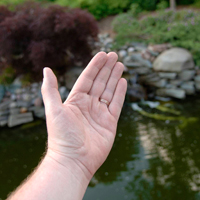If No Light Falls On an Object Does It still Have a Color?
Like the philosophical question about the sound of a tree falling in a forest, this is a question of perception. Since color is a visual perception and light is the stimulus that produces visual perception of objects, then with no light there is also no color. At least there is no color that belongs to that object. We might still perceive color due to the dark noise in our visual system. For example, when we are in a completely darkened room for a long period of time (so that we completely adapt), the perception is not one of black (which only exists as a related color), but one of a noisy (or grainy) dark gray.
It is, of course, possible to perceive color without visual stimulation, but such colors would not be associated with specific objects in our environment since we couldn't see them. Dreams are one example. We can have clear color perceptions of imagined objects when we are dreaming. And, yes, people do perceive dreams in color. Although for some people it is difficult to recall dreams and some people do claim that their dreams are only in black and white. Another non-visual color perception comes from pressure on the eye. If you press gently at the corner of your eye you will see some bright flashes due to this pressure. These are known as pressure phosphenes. It is not very good for your eyes to press on them, so I don't recommend doing this experiment more than once and even then be very gentle. One could also consider afterimages as non-visual color perceptions since they result from the removal of the light stimulus rather than its presence. However, they are really still produced by visual stimulation.
These types of questions can never be answered definitively. That's what makes them philosophical in nature. It is fun to ponder them and discuss the possible answers with others. Such thoughts and discussions can lead us into greater insights about ourselves and the world around us. Another one to ponder from The Gateless Gate ... "The wind is flapping a temple flag, and two monks were having an argument about it. One said, 'The flag is moving.' The other said, 'The wind is moving.' They argued back and forth but could not reach the truth. The sixth patriarch said, 'It is not the wind that moves. It is not the flag that moves. It is your mind that moves.' The two monks were struck with awe."
![]()
Explore the NEXT TOPIC at this level.
Explore the NEXT LEVEL on this topic.
Ever wonder ... How does light affect how bright a color appears?
Updated: Aug. 9, 2010

